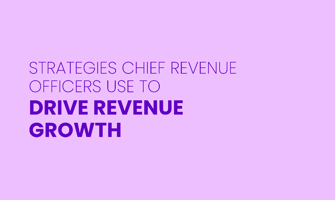Chief Revenue Officers (CROs) integrate sales, marketing, and customer engagement to optimize a...
The Essential Skills Every Chief Revenue Officer Needs
The role of a Chief Revenue Officer (CRO) requires a comprehensive understanding of all business aspects, including marketing, sales, and customer service, to ensure these functions are aligned and working together towards revenue growth.
This article highlights the essential skills every successful CRO needs. You can learn how to master revenue forecasting and budgeting, understand market insights and trend analysis, and explore why each skill is crucial for driving business growth. Also, it provides practical techniques to improve these skills further.
How the CRO Role Drives Growth
The Chief Revenue Officer (CRO) is responsible for creating strategies to boost revenue and aligning various departments to achieve this goal.
A CRO ensures departmental harmony by setting clear objectives and ensuring everyone understands their role in meeting revenue targets. For example, marketing attracts potential customers, sales convert leads into paying customers, and customer service retains these customers through excellent service.
Regular communication is crucial for alignment, involving weekly updates or project management tools for transparency.
As part of the executive team, a CRO uses data analysis to shape business strategy. Continuous learning about industry trends and best practices enhances decision-making skills.
An effective CRO not only increases sales but also improves overall business performance by streamlining operations and implementing new technologies to increase efficiency.
Essential Skills Every CRO Needs
1. Revenue Forecasting and Budgeting
Revenue forecasting is the process of estimating future sales. It provides an educated guess about how much revenue will come into your business over a certain period. On the other hand, budgeting involves planning how to spend that anticipated income to achieve maximum profitability.
Why It Matters
Strategic Planning: Accurate forecasts provide an estimate of future revenues, which can guide the CRO in decision-making processes. For instance, if the CRO predicts higher sales in the next quarter, they might decide to invest more in production or marketing.
Resource Allocation: With precise budgeting, the CRO can allocate resources effectively across different departments or projects. It ensures that all money spent contributes towards achieving business goals.
Risk Management: Forecasts help predict potential downturns or challenges ahead of time, and the CRO can prepare contingency plans to mitigate risks.
Techniques to Improve Revenue Forecasting and Budgeting
Leverage Advanced Analytics and Forecasting Tools: Utilize advanced analytics and specialized forecasting software to process and analyze historical data. These tools can detect patterns, predict trends, and provide more accurate revenue forecasts. By incorporating machine learning algorithms, you can continuously improve your predictions and make data-driven decisions.
Implement Scenario Planning: Develop multiple revenue scenarios, like best-case, worst-case, and most likely case, to anticipate various future conditions. Scenario planning helps you prepare for different outcomes and create flexible budgets that can adapt to changing market conditions.
Regularly Review and Adjust Forecasts: Establish a routine for frequently reviewing and updating revenue forecasts based on the latest data and market developments. This iterative process allows you to respond quickly to changes, refine your predictions, and adjust your budgets accordingly. Regular reviews ensure that forecasts remain relevant and actionable, leading to better financial planning and resource allocation. This continuous adjustment keeps your budget aligned with the company's financial goals and market realities.
![]()
2. Market Insights and Trend Analysis
Market insights and trend analysis refer to gathering, analyzing, and interpreting data about market conditions. This includes understanding customer behavior, competitor activities, industry developments, and broader economic trends.
Why It Matters
Strategic Decision Making: By keeping an eye on the market, the CRO can make informed decisions. They can know when to launch new products or services, which markets to target, and how to position the brand effectively.
Competitive Advantage: Understanding trends before competitors do can give the CRO a head start. This allows them to adjust their strategies accordingly and stay ahead of the competition.
Customer Satisfaction: When the CRO understands what customers want, they can tailor offers to meet their needs. This leads not only to increased sales but also higher customer satisfaction levels.
Techniques to Improve Market Insights and Trend Analysis
Utilize Data Analytics Tools: Implement data analytics tools to gather and analyze data from various sources, such as customer interactions, social media, and market reports. These tools help identify emerging trends and predict future market conditions, providing actionable insights for strategic decision-making.
Engage in Continuous Market Research: Conduct regular surveys, focus groups, and customer interviews to stay updated on market developments and customer preferences. This ongoing research enables you to quickly adapt to industry shifts and capitalize on new opportunities.
Perform Competitor Analysis: Regularly track and analyze competitor activities by monitoring their websites, social media channels, press releases, and customer reviews. Use tools like web scraping and social listening platforms to gather data on product launches, marketing strategies, and customer engagement. Understanding your competitors' strategies and market positioning helps you identify gaps and adjust your strategies to stay ahead in the market.
3. Product and Customer Lifecycle Management
Product and customer lifecycle management involves overseeing the stages a product goes through from development to decline and managing the customer journey from awareness to loyalty.
This dual focus helps CROs make informed decisions that enhance both product value and customer satisfaction.
Why It Matters
Maximizing Customer Value: Understanding the customer journey allows CROs to add value at each stage. By offering personalized recommendations and special promotions based on customer behavior, CROs can enhance customer experience and foster loyalty, ultimately driving higher revenue.
Increasing Retention: Monitoring the customer lifecycle enables CROs to identify when customers might be about to churn. Implementing targeted email campaigns or offering incentives to retain these customers helps maintain a stable revenue stream and reduces customer acquisition costs.
Efficient Resource Utilization: A well-managed product lifecycle ensures resources aren't wasted on underperforming products while promising ones get the necessary attention. On the other hand, by focusing on retaining existing customers rather than constantly acquiring new ones which can cost five times more businesses save money which positively impacts profitability.
Techniques to Improve Product and Customer Lifecycle Management
Use CRM software: Customer Relationship Management (CRM) software tracks and analyzes customer interactions over time. This data helps you understand customer needs and behaviors, allowing for more personalized and effective engagement strategies.
Regularly review sales data: Analyze sales data to identify patterns and trends. Look for seasonal variations or the impact of marketing campaigns on product performance. Use these insights to adjust strategies and optimize resource allocation.
Encourage feedback: Actively seek customer feedback through surveys, reviews, and direct communication. Use this feedback to make continuous improvements to your products and services, ensuring they meet customer expectations and drive satisfaction.
![]()
4. Pricing Strategy and Management
Pricing strategy and management refers to the method used to set prices for products or services in an organization. This involves understanding what customers are willing to pay, considering market conditions, and assessing how different pricing models might impact revenue and profitability.
A well-thought-out pricing strategy can make all the difference between driving sales growth or falling behind competitors.
Why It Matters
Revenue Impact: The pricing of products or services directly affects revenue. If prices are too high, sales may decrease; if they're too low, profit margins can suffer. A CRO needs to understand this delicate balance.
Competitive Positioning: Pricing plays a crucial role in how a business is perceived in the market. Setting competitive prices can help attract more customers and help the CRO gain an edge over competitors.
Customer Perception: Price often reflects quality in the eyes of consumers. A well-thought-out pricing strategy can enhance customer perception of the value received, leading to increased loyalty and repeat purchases.
Techniques to Improve Pricing Strategy and Management
Leverage Value-Based Pricing: Determine the value your product or service provides to customers and set prices accordingly. Conduct customer interviews and surveys to understand their perceived value. This ensures your pricing reflects the benefits and solves specific pain points for your customers.
Implement Dynamic Pricing: Use dynamic pricing strategies to adjust prices based on real-time demand, competition, and other external factors. Employ pricing software that analyzes market trends and sales data to automatically adjust prices. This approach helps maximize revenue by capturing the highest price customers are willing to pay at any given time.
Conduct Regular Price Optimization Analysis: Regularly review and analyze pricing performance using advanced analytics tools. Look at key metrics such as price elasticity, customer acquisition costs, and profit margins. Use these insights to fine-tune your pricing strategy, ensuring it remains competitive and aligned with business goals.
5. Revenue Operations Optimization
Revenue operations optimization involves fine-tuning all revenue-related processes within an organization to ensure they're as efficient and effective as possible.
This includes everything from sales and marketing activities to customer service interactions, with the ultimate goal being to maximize revenue generation while minimizing costs.
Why It Matters
Efficiency: Optimizing revenue operations means identifying bottlenecks in the business process and finding ways to eliminate them. This leads to smoother workflows, saving time that can be better spent on other important tasks.
Cost Reduction: Streamlined processes often mean less waste. Whether it's reducing unnecessary steps or automating manual tasks, the CRO's ability to optimize revenue operations can lead to significant cost savings.
Scalability: An optimized operation is easier to scale up as the company grows. The ability of a CRO to efficiently manage growth directly impacts the bottom line.
Techniques to Improve Revenue Operations Optimization
Implement Advanced Process Mapping: Conduct thorough process mapping to identify every step in your sales, marketing, and customer service processes. Use flowchart software to visualize these processes and pinpoint redundancies or unnecessary steps. By streamlining these steps, you can eliminate inefficiencies and improve overall workflow.
Enhance Data Integration: Integrate data from various departments such as sales, marketing, and customer service into a centralized system. 180ops provides comprehensive solutions for data management and operational efficiency by integrating CRM, customer service, and sales data with real-time insights. This holistic view enables better decision-making and synchronization across all revenue-related activities.
Utilize Performance Metrics and KPIs: Establish and monitor key performance indicators (KPIs) for all revenue-related activities. Use dashboard software to track metrics like sales conversion rates, customer acquisition costs, and marketing ROI. Regularly review these KPIs to identify areas for improvement and make data-driven adjustments to optimize operations.
6. Partnership and Channel Development
Partnership and channel development involves identifying potential business partners, establishing beneficial relationships, and managing these partnerships effectively.
It also includes creating and optimizing various channels through which a company sells its products or services, whether direct like an in-house sales team, or indirect like distributors or resellers.
Why It Matters
Driving Revenue Growth: Building strategic partnerships allows the CRO to tap into new customer bases, thus driving revenue growth. For instance, partnering with a company that offers complementary products or services can expose your business to their audience.
Expanding Market Reach: Developing channels means finding new ways to get products or services in front of potential customers. This could be through online platforms, retail stores, or even international markets.
Enhancing Brand Reputation: Partnerships often lend credibility to the brand as they show trust from other established businesses in the industry.
Techniques to Improve Partnership and Channel Development
Strategic Alignment: When considering potential partners, ensure there is strategic alignment between both companies' goals and values. Conduct thorough due diligence (an investigation or audit of a potential investment) to understand their market position, customer base, and business objectives. This ensures a mutually beneficial partnership that drives growth.
Diversify Sales Channels: Diversify your sales channels based on where your target customers are most likely found. Analyze customer behavior and preferences to identify the most effective channels, whether they are online platforms, retail locations, or third-party resellers. This approach maximizes market penetration and revenue opportunities.
Regular Evaluation: Regularly evaluate the effectiveness of each channel and partnership using performance metrics such as sales volume, customer acquisition costs, and ROI. Use this data to make informed decisions about continuing, modifying, or discontinuing partnerships and channels. Continuous evaluation and optimization ensure sustained growth and profitability.
![]()
Conclusion
The role of a Chief Revenue Officer (CRO) is important for driving business growth and ensuring all departments work harmoniously towards revenue goals. Mastering skills like revenue forecasting, budgeting, performance measurement, and staying informed about market trends and technological advancements is essential.
Developing these essential skills will better equip you for future challenges and ensure optimal business impact. Whether you're already in this role or aspiring to it, focusing on these areas will help you succeed and drive your organization forward.
FAQs
What are the main responsibilities of a VP of Sales in a start-up or growth company?
The main responsibilities of a VP of Sales in start-ups or growth companies include developing and executing a strategic roadmap to accelerate revenue growth, managing the sales pipeline, and converting leads into sales-qualified leads. They also collaborate with marketing and sales teams to drive revenue generation.
What qualifications are necessary for a VP of Sales role?
Typically, a VP of Sales should have significant experience in leadership roles, particularly in B2B companies. They should possess strong skills in revenue management, customer success, and automation, along with a proven track record in accelerating revenue growth.
Can you provide a sample job description for a VP of Sales?
A sample job description for a VP of Sales might include: "The VP of Sales will lead the sales team, develop and execute sales strategies, and manage the sales pipeline to achieve company targets. This role involves working closely with the marketing team to align efforts and maximize revenue generation. The VP of Sales will also play a key role in content creation for sales campaigns and ensuring customer success."
What are the objectives of a VP of Sales in a B2B company?
The primary objectives of a VP of Sales in a B2B company include driving revenue generation, expanding market reach, and establishing a strong distribution network. They aim to develop a robust revenue engine by converting leads into sales-qualified leads and ensuring customer success throughout the sales process.
How does a VP of Sales contribute to the overall revenue generation engine of a company?
A VP of Sales contributes to the revenue generation engine by setting bold moves and strategic initiatives that drive sales and revenue. They leverage generative AI and other automation tools to optimize sales processes and achieve the company's revenue targets. Their leadership ensures that the company excels in competitive markets and maintains steady growth.




